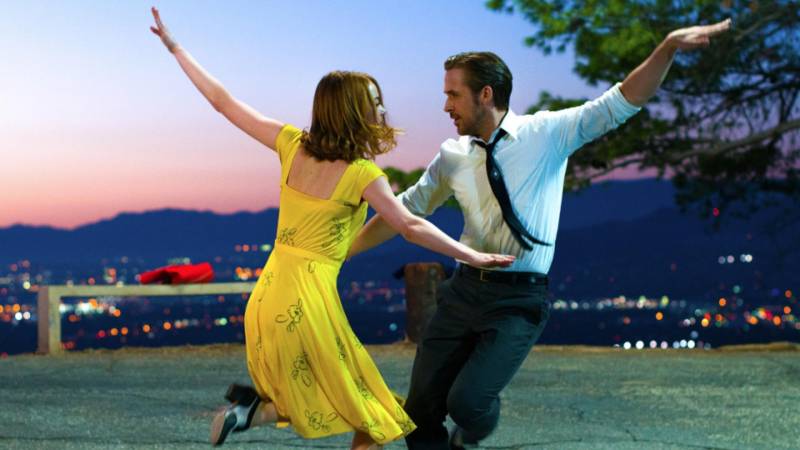May Hong HaDuong, director, UCLA Film & Television Archive; Film and Television Archive – which collaborated with BAMPFA on the “Cities and Cinema: Los Angeles series. The series runs through October 3 at BAMPFA in Berkeley.
Interview highlights:
The “Cities and Cinema: Los Angeles” Series at Berkeley’s Pacific Film Archive
The new series at Berkeley’s Pacific Film Archive, running through October 3, considers a selection of films that foreground the history, architecture, and neighborhoods of Los Angeles. May Hong HaDuong, director of the UCLA Film & Television Archive, collaborated on the series. “Susan Oxtoby, who’s their tremendous curator there, really conceived the series as a way to honor the kind of stories that you see in LA,” she says.
The series includes mainstream Hollywood films like “Chinatown” and “La La Land,” but also highlights independent works reflecting various communities’ experiences in LA. One such film is “Hito Hata: Raise the Banner,” described by HaDuong as “one of the first Asian American films made by Asian Americans” and a “tremendous story made by two incredible pioneers, Robert Nakamura and Duane Kubo.”
The Significance of “Killer of Sheep” and the LA Rebellion Filmmakers
A major focus of the series is the groundbreaking 1977 film “Killer of Sheep” by director Charles Burnett, which HaDuong calls “just an incredible poem. It’s an incredible neorealist film.” She notes that Burnett “went and shot the film over a series of weekends, and really to tell a story of Stan. He’s a blue collar African American, who is living his life basically as a family man, as a laborer, as a father.”
“Killer of Sheep” emerged from the “LA Rebellion” movement of filmmakers of color at UCLA in the 1960s and 70s, as HaDuong explains: “UCLA had this burgeoning moment, with independent cinema where a lot of students of color were being recruited and also filmmakers, and artists were… pushing against the tropes of Hollywood, but also using the same storytelling techniques, to tell their own stories.”
Capturing the Reality and Diversity of LA Beyond Hollywood Fantasy
Guest Elvis Mitchell highlights how pioneering LA films like “Killer of Sheep” offered an important counterpoint to the typical Hollywood fantasy depictions: “I think that Killer of Sheep, like so many great LA films, exist as this kind of answer to the dream factory aspect of of movies about LA that maybe existed until the nineteen sixties and seventies.”
The guests discuss how capturing the real, diverse neighborhoods and communities of LA is essential for truthfully portraying the city on film. As Amy Nicholson states, “I think it’s wonderful that two of the most major filmmakers who came up in the nineties, Quentin Tarantino and Paul Thomas Anderson, were both people who grew up on the outskirts of LA, not in Hollywood proper. Quentin Tarantino grew up a lot in Torrance. Paul Thomas Anderson is obviously from the Valley. And so when they made their movies here, their whole mission [was] in a way showing overlooked corners of LA.”
Mitchell recalls the artificiality of many of the LA-set movies of the 50’s and 60’s, particularly those set on the beach. “I think, certainly, whenever we think about LA, we think about the beach. And I find myself [thinking] of the movies that have received reruns on television, all those beach blanket movies, you know, the Annette Funicello, Frankie Avalon films that made surfing seem like something that only Ken and Barbie could do”
Iconic LA Movie Locations and Neighborhoods
Discussing specific iconic LA filming locations, caller Ben fondly recalls the iconic Hollywood Hills home featured in the noir classic “Double Indemnity,” while Daniel praises the use of the Bradbury Building in “Blade Runner” as an architectural landmark.
Nicholson adds: “I really love how David Lynch captures the irony of living in a town this sunny that has a sordid side, this beautiful that has a sordid side. You know, Mulholland Drive and Inland Empire, they really get that clash between how LA looks and how LA can feel if your life in LA is not going as planned.”
Mitchell bemoans the loss of many local landmarks. “Chinatown is a film that’s all real locations for the most part. And a lot of those locations have disappeared. That city, a lot of that Los Angeles is gone. And I think what breaks my heart.”
This content was edited by the Forum production team but was generated with the help of AI.
